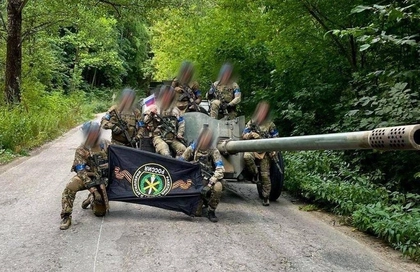Ukrainian Marine Oleksandr Didur has come a long way since a Russian tank tried to kill him.
Didur, 30, is married and the father of two children, a son now seven and a daughter eighteen months old. She was born shortly after the war started and she has never seen him whole.
JOIN US ON TELEGRAM
Follow our coverage of the war on the @Kyivpost_official.
On April 6, 2022, Didur, a veteran sergeant serving with the Armed Forces of Ukraine (AFU) since 2015, was leading a scratch detachment holding a four-story industrial building outside the Ilych steel mill, in the northern outskirts of Mariupol. The city was under siege and constant Russian bombardment, and everything was running out.
He had twelve men from the 36th Marine Brigade, most trained not as infantrymen but as anti-aircraft gunners, and they had been fighting nonstop for more than two weeks.
Those Marines’ mission that day was to stop Russian attacks from breaking into the factory premises. The Ukrainians had no mortar rounds, no anti-armor weapons, no mines – just rifles and grenades. The Russians were driving their tanks right up to the Ukrainian positions.
Didur left his men on the ground floor of the building, took an assistant up to the third floor, told him to wait as a backup, and climbed to the fourth floor. The idea was to use the height of the building to spot the advancing Russian tanks. At one point, Didur looked out a window and saw a Russian tank about 300 meters away with its barrel pointed straight at him.

Ukraine’s Elite Special Ops: Top Missions of 2024 – From Black Sea to Kursk
In an account of the combat to Kyiv Post, Didur recalled he just had time to turn and start a leap out of the way when the Russian 125mm high explosive shell detonated about three meters away.
Wounded Ukrainian Marine Oleksandr Didur (L) receives instruction in proper posture from therapist Anna Nikonenko (R) during a physical therapy session on Sep. 12. Didur was injuring in fighting in Mariupol in April 2022. He was taken prisoner and only received proper medical care and started physical rehabilitation following a prisoner exchange in July 2023. Photograph by Stefan Korshak.
The explosion ripped three of the fingers off his (dominant) right hand and drove metal splinters and building debris up and down the left side of his body. Something sharp ripped open his left arm for about 25 cm. Something snapped the bone just above his right elbow in half. He lost consciousness.
But the most dangerous injury, Didur later learned, was a pea-sized irregular chunk of metal that struck his left eye, destroyed it, and tore deeper into his skull to come to rest against his brain. Months later, an X-ray technician found 28 separate bits of metal or concrete in his body. By that time, Didur had become almost used to people telling him he shouldn’t be alive.
On that Wednesday on the fourth floor of that building in Mariupol, Didur was alone, unable to move or put on a tourniquet and bleeding out fast. Even in armies with proper evacuation wounded and medical supplies in quantity - which Ukrainian forces did not, at that time and place - a man in that situation pretty much always dies.
The other Marines in Didur’s section chose not to make the tactically correct move - get out of the building before the Russian tanks leveled it. Instead, a medic and a couple more soldiers clambered upstairs to drag Didur out of the debris, while the rest tried to distract the Russians by sprinting from building to building in the area, opening up with their rifles for a few seconds, and then high tailing it somewhere else.
Didur told Kyiv Post it was only much later that he learned how his team counterattacked against tanks to save him and get him to the battalion casualty clearing point.
According to Didur’s account, which doctors and therapists later confirmed to Kyiv Post, medics doing triage checked out his injuries and concluded he was going to die and went on to less wounded soldiers they had a better chance of saving.
But Didur kept on breathing, so after a while, he said, the medic came back and decided to try and keep him alive after all.
Didur’s next fragmentary memory is being on a bus with other wounded and driving somewhere. On April 12 the Ukrainian Marines retreated from the Ilych steel mill, but before doing so somehow contact with Russian forces was made, and a turnover of severely wounded was arranged.
Along with about 20 other men far too badly injured to move, the bus was hauling Didur into captivity. He was now a prisoner of war. Once he regained consciousness, he said, his most intense memory was no painkillers.
For the next fourteen months, the Russian army and later prison doctors intermittently inspected Didur’s injuries and usually, they told him he should be dead. No one operated on his arm, it stayed broken for more than a year. Aside from jury rigs attempted by Ukrainian medics also prisoners of war, the break never was set. Medicine and particularly antiseptics were hard to come by in the Russian prison. For months, Didur was unable to feed or clean himself.
Didur’s worst wounds got stitched by Ukrainian military doctors in the barracks, but there was nothing anyone could do about his left eye and the shard next to his brain. Medics told Didur not to move around too much, because the splinter might move and kill him.
By his account, Didur spent much of his time learning to pick things up with the little finger and thumb of his left hand, and trying to keep the muscles and nerves in his shredded right arm from atrophying completely.
The Russians fed Ukrainian prisoners a diet of bread, tea, weak soup and intermittent vegetables, so it wasn’t easy to get stronger.
The gashes and punctures in his flesh took about three months to knit, and chances of gangrene – potentially fatal in a Russian prison – were high. But his wounds never got infected.
On July 29, 2022, Didur was one of the Ukrainians held at the Olenivka prison facility in the occupied Luhansk region, where an explosion apparently set off inside a barracks killed more than 50 POWs and injured more than 100.
Two days prior Russian warders lined up all prisoners – including the still-immobile Didur – and selected, by name, the Ukrainians that were placed in the barracks. Almost all from the Azov Regiment. Didur is a Marine. He wasn’t picked.
On July 6, 2023, Didur was bused back into free Ukraine as part of a prisoner exchange. His strongest memory of that time, he said, was that when he met his infant daughter for the first time, she already knew him from pictures her mother had shown her.
If you ask Didur how he survived Russian prison, he will say it is thanks to his wife’s support, and personal discipline learned in Muy Thai boxing.
By the standards of the Russo-Ukrainian war, Didur’s fighting days ended a long time ago but, his injuries only now are getting professional treatment. In a private clinic in the Kyiv suburban town Bucha, therapist Anna Nikonenko said thanks to private corporate donations, any AFU member who fought at Mariupol effectively will have all his medical bills, including therapy potentially lasting for years, paid for him.
In one exercise, Nikonenko talked Didur through reps designed to strengthen his right arm, on a wheel apparatus one twists using mostly the wrist and forearm muscles. For a healthy person, it would be simple. For Didur, five minutes of twisting the little wheel left him sweating and gritting his jaw – but he did it, and the extra reps Nikonenko suggested too.
Ukrainian physical therapist Anna Nikonenko (R) helps wounded Ukrainian soldier Oleksandr Didur (L) engage with a therapy device on Sep. 12 in a rehabilitation center in Bucha, Ukraine. Didur’s arm was severely damaged by a tank shell. It was more than a year before he received proper medical treatment. Photograph by Stefan Korshak.
Didur’s right arm humerus now – fourteen months after it was broken – contains a titanium section bought by corporate donor money and making the bone whole. He still receives his military salary, so his wife and children are fed and clothed, he said.
As for the metal shard next to his brain, Didur’s doctors say his body seems to have built a protective capsule around the splinter. In mid-August, he was waiting to schedule a cosmetic operation to repair the looks of his left eye socket and cheek, but he won’t ever see again out of that eye. The doctors say they probably can get his left eyelid working again and that he can have any replacement eye color he wants.
Didur told Kyiv Post he has no concrete plans about how to live the rest of his life. His hometown, Orikhiv, is occupied by the Russians and he has years of therapy ahead of him. He said ideally, someday, he would like to put together an organization that helped injured veterans like himself.
“There are a lot of us,” he said.
You can also highlight the text and press Ctrl + Enter








